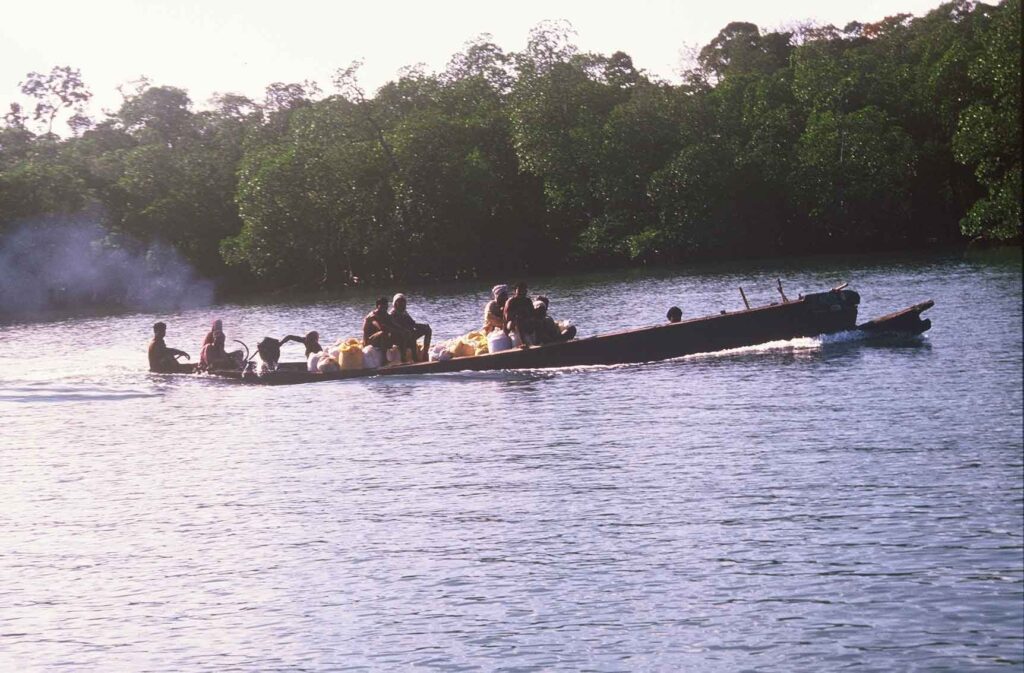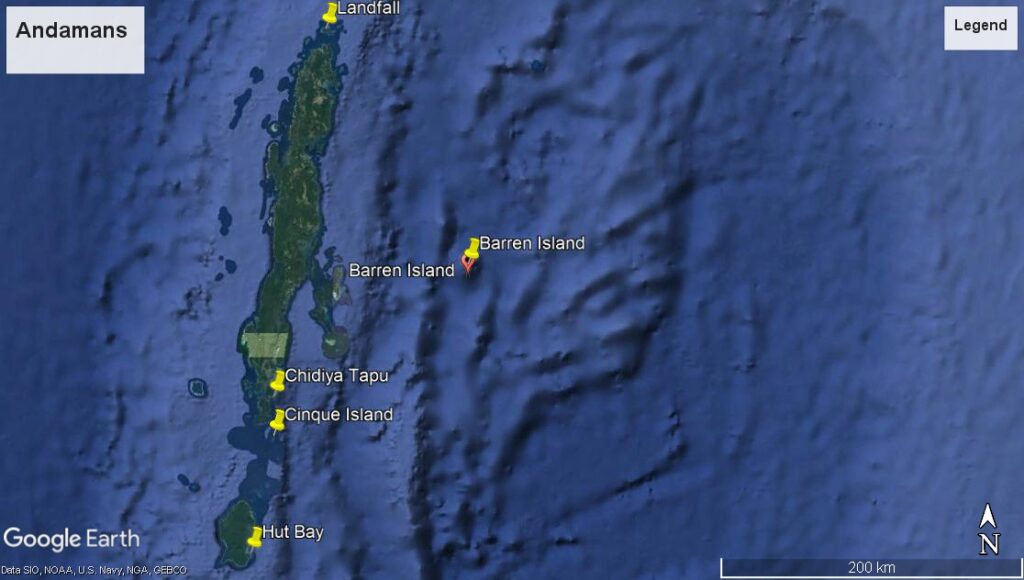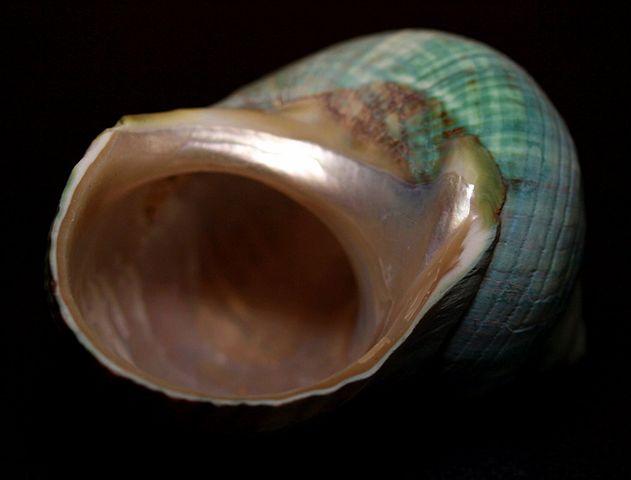This is the second instalment of a two-part series on trochus fishery and conservation in the Andaman and Nicobar islands. Click here to read part one.
The trade in trochus—or top shells—was an important part of the economy of the Andaman Islands for almost a century. The first part of this series pieced together voices from the archives to describe how interest in this marine resource forged connections between different people and places, not only within the Andaman Islands but also with other parts of the world. Further, the archival material indicates that the regulation of trochus fisheries was a tricky endeavour from the start and it eventually failed because neither the fishers nor the government paid enough attention to questions of conservation and sustainability.
To both complement and counterbalance the voices in the archives, this article presents the memories and experiences of fishers who used to dive for trochus shells and how they dealt with these major changes.
Crafting Gear
It appears that the Japanese fishers who operated in the Andamans waters in the 1920s did indeed play an influential role in the islands’ shell economy, as the Karens learned trochus fishing from them. Many fishers recalled how they used halis dunghis—or unmotorized boats, propelled by rowing—and collected the shells by freediving, well into the 1990s. The area they covered and the quantum of shells they harvested were capped by the physical prowess of the fishers.

During interviews, the only piece of equipment fishers mentioned using was a pair of hand-made goggles. The Karens learned to make these from the Japanese: it involved carving out the frame from the wood of a hardy tree—such as padauk—and cutting a piece of rectangular glass with a dao, or a small blade, to make the eyepiece. They would seal the glass to the wooden frame with beeswax to keep it watertight and bind the goggles to the head using a strip of rubber, usually cut out from the tube of a cycle tyre.
One of the fishers, Saw Frank*, described how he would use an embroidery hoop and wrap rubber tubing around it to make the circular frame of the mask. Then he would spend 1-2 hours cutting the glass carefully, with a dao, and fit it into the frame after smoothening the rim with sandpaper. Masks with oval frames came into circulation only much later, when one of the takedars—or shell dealers—brought back a sample from the mainland and showed it to some of the Karen fishers.
Bengali shell fishers too narrated similar stories of the physical effort and resourcefulness involved in shellfishing. Even their shell-collecting bags were made of repurposed material: old banians (tied at the bottom with the shoulder straps forming the handles) and jute sacks. Moreover, if the fishers were Karen, it was quite likely that they had constructed the boats too themselves. These intrepid men fished in locations all over the Andamans archipelago: Chidiyatapu, Hut Bay, North and South Brother, Chipo, Landfall, Cinque, Barren. Later, motorized boats made it easier for them to cover large distances although it increased the cost of operations.

The Fishing Trips
On diving in the Andamans for shells, Uncle Maung recalls, “We would go in groups of 10-15 dungis with at least 3-4 men in each, and dive in one area. We carried our rations with us. One person would sit in each boat and keep it anchored while the rest of us would enter the water.” He adds, “We used to see crocodiles too because they rest in shallow pits on the sandy seabed. But they wouldn’t attack us unless provoked.”
Another, fisher Gaurav-da, said the fishers initially used rings made of cane to tie the oars to their wrists. But, these used to break often during long journeys, or when the dunghi was heavily loaded—they could return with as much as a ton of shells after a month of diving. He remembers the advent of plastic oar rings as a definite step forward for the fishery. “We got a lot of good food, fresh from the sea,” says Gaurav-da. “In the early days, people used to hunt some wild pig and deer too. All of it for free!”
However, there was serious competition between the shell fishers and no fixed ties between fisher groups—whoever was free at a given time banded together in a group and went diving. Each fisher would try to collect as many shells as he could and would store his catch at a secret place on the beach until it was time to load the boat—if they stored the shells in a commonplace, there used to be fights about who had collected how much. They collected shells that were at least 6 inches in diameter since the takedars did not accept smaller ones. Some of the Karen fishers also said that in a few parts of the North Andamans, you could collect trochus shells by simply walking along a rocky coastline in low tide, when there was just knee-deep water—that is, from the intertidal zone.
After collecting the shells, the fishers would soak them in cauldrons of hot water to clean the mud off the shell, kill the snail within, and soften its meat so that it could be extracted with a knife or metal wire. Many of them remembered how much the shells stank if you did not clean them thoroughly as the snail rotted inside—the takedar would offer a low price for such a catch.
Speaking of the snail, Saw Frank describes the foot as being white while the innards are black; according to him both are edible but most Karens ate the white part alone. The Bengali fishers say they do not eat the snails at all. If it was a large catch, the meat could be sun-dried to preserve it—it just needed to be soaked again in hot water before it was fried with oil and onions. If you added lime juice and Burma dhania—or coriander—it made a tasty trochus snail salad!

The Role of the Takedars
The cleaned trochus shells were taken to godowns, where the takedars would “put them in net bags, like potatoes and weigh them”—to Lohabarrack or Sippighat if you were a fisher from South Andamans, or Mayabunder if you were from the north. The takedar would subtract the amount he had furnished to each shell diver as an advance—for purchasing rations for the boat—and then pay them the remaining amount.
Some divers recalled how the takedars initially paid them about ₹30-40 per maund—1 maund is approximately 40 kilograms, while around 80 pieces of trochus made 1 maund. Although hazy about the time frame, over the years, this increased to about ₹1200. This was a high-income job, as one diver explained, because in the same period, for instance, the Forest Department was paying ₹72 for an entire month’s work in the forestry sector.
Although takedars often get a bad name in the fisheries sector for acting as exploitative middlemen, the shell fishers I interviewed spoke of how the takedar’s support could ease their difficulties. They described how the advance he provided was essential for them to hire a boat and assemble the rations to go fishing. Some fishers mentioned how, if they were well-known to the takedar, they had the flexibility to decide if they wanted to pay back the advance in one instalment or many. Others spoke of how the takedar had mobilized search parties and rescued them when they had lost their way in a storm, or how the takedar had provided some money for medical expenses when they injured themselves during fishing trips. This is no small gesture, especially given that many of the fishers suffer from diving-related ailments such as chronic lung problems, high blood pressure, and joint pains.
Trochus shells were often found alongside the rarer turbo shells. As Ismail Khan, an elderly trader put it, they are “like brother and sister shells.” The latter is even more iridescent and hence more valuable. Ismail remembers how when polished and set in gold by Burmese craftsmen, turbo shells used to be mistaken for semi-precious stones. The trader recalled that both trochus and turbo shells were exported via Calcutta, for ₹30-40,000 per ton, to meet the demand in South Korean, Japanese, Thai and Taiwanese markets.

Many divers, on the other hand, did not know where exactly the shells were eventually sold, or what the market rates elsewhere were. As one of them said, “Sirf payment main interest tha [we are only interested in being paid].” This singular interest also meant that some of them sold their shells to a takedar other than the one allotted to their fishing zone, because they got a better rate from the former—even 50 paise more per maund was significant those days, especially if you calculated the value by the boatload.
Thomas, who was very young when he began collecting trochus, said he simply sold his catch to anyone who offered a good price because his only ambition was to be able to buy red canvas shoes from a shop in Mayabunder. In those days, canvas shoes were greatly in demand amongst the Karens and you could choose between two colours—white or red. But those with more business acumen used the money to start a small enterprise such as a grocery shop, transport service or carpentry unit. Some of the Bengali fishers said they invested in buying land and creating areca nut plantations, which in turn brought them even more profits.
Learning From History
When the ban on shellfishing came into force in 2001, due to massive declines in the trochus populations and near-extinction of turbo snails, some fishers admitted to continuing shell fishing albeit illegally. But this did not persist for long or in large volumes because it was difficult to transport the shells to the mainland. Takedars in the islands offered very low prices for the catch due to the high risks involved. And so, many of these fishers simply shifted to other fishing high-value organisms such as sea cucumbers, lobsters, and groupers.
However, it remains that the group most affected by the ban was the local shell craft traders. In 2008, the Andaman and Nicobar Islands Sea Shell Artisans Welfare Association petitioned the government to rescind the ban. Following this, the Directorate of Industries requested the Zoological Survey of India to once again carry out surveys and stock assessments of trochus snails, some 60 years after the first ones were completed under colonial rule. Their 2010 report recommended that regulated fishing be permitted initially for three years and be followed by a stock assessment to gauge if the shell beds remained healthy. However, the National Board for Wildlife decided that the ban should be retained since the shell beds had not fully recovered.
As researchers have noted, the trochus case is consistent with the general trend seen in these islands: fisheries tend to follow a typical boom and bust pattern. There is intensive harvesting when there is a high market value for the species, which inevitably causes a crash in the population—this makes it economically and ecologically unviable to continue harvesting it, even in the absence of a ban. As a result of this, some fishers suffer serious economic deprivation and move to other sources of livelihood, while most shift to exploiting the next marine resource. Government schemes too facilitate such short-term thinking, because they emphasise maximising harvests and subsidize intensive fishing techniques.
Is there anything to be learnt from this abbreviated history of trochus fisheries in the Andaman Islands? Archival records often accuse fishers of other countries of plundering the shell beds of the Andaman Islands—this is heard in popular discourse as well. However, we have to recognize that others, such as the Pacific Island countries—including French Polynesia and Palau—have been able to sustain their trochus fisheries, something that continues to be lacking in the Andamans.

In the case of trochus, sustainable fishing typically involves a combination of ranching methods and harvesting from the wild, with both minimum and maximum size limits, and a short harvesting season. In addition, community involvement in monitoring the populations as well as the rate of extraction is often more effective and less expensive than leaving it to a handful of experts; more so if the shell fishers can form cooperative societies to market the raw shells or craft them into various products. For instance, the Aitutaki trochus fishery in the Cook Islands has sustained itself for more than 50 years now although trochus is not even native to these islands.
On the other hand, with the availability of sophisticated plastic buttons, the demand for trochus buttons has fallen worldwide, diminishing the income of shell fishers even in countries with high trochus harvests. Perhaps there is also a case to be made for not putting all our shells in one basket.
Acknowledgements: the author thanks all the shell fishers and traders who kindly made time for interviews, Saw Isaac for Karen translations, and the staff at the State Archives of the Andaman and Nicobar Islands for granting permission and extending ready assistance.
For more on coastal India’s past, present, and future, curated by The Bastion and Dakshin Foundation under “The Shore Scene”, click here.
*Names of respondents have been changed to maintain confidentiality. | Featured image: courtesy of Manish Chandi.
References:
Advani, S., A. Sridhar, N. Namboothri, M. Chandi and M.A. Oommen. 2013. Emergence and transformation of marine fisheries in the Andaman Islands. Dakshin Foundation and ANET, Bangalore.
Files from the State Archives of the Andaman and Nicobar Islands.
Gillett, R., McCoy, M., Bertram I., Kinch, J., and Desurmont, A. 2020. Trochus in the Pacific Islands: A review of the fisheries, management and trade. Pacific Community, New Caledonia.
Ramakrishna, Raghunathan, C. and Sivaperuman, C. 2010. Status Survey on Trochus niloticus (Linnaeus, 1767) in Andaman and Nicobar Islands. Status Survey of Endangered Species. Zoological Survey of India, Kolkata.







[…] This is the first instalment of a two-part series on trochus fishery and conservation in the Andaman and Nicobar islands. Click here to read part two. […]